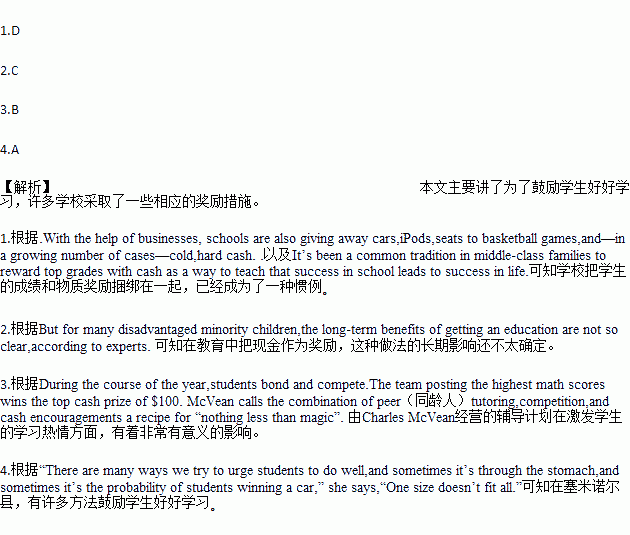题目内容
Facing increasing pressure to raise students’ scores on standardized tests,schools a re urging kids to work harder by offering them obvious encouragements.Happy Meals are at the low end of the scale.With the help of businesses, schools are also giving away cars,iPods,seats to basketball games,and—in a growing number of cases—cold,hard cash.The appeal of such programs is obvious,but the consequences of tying grades to goods are still uncertain.It’s been a common tradition in middle-class families to reward top grades with cash as a way to teach that success in school leads to success in life.But for many disadvantaged minority children,the long-term benefits of getting an education are not so clear,according to experts.
re urging kids to work harder by offering them obvious encouragements.Happy Meals are at the low end of the scale.With the help of businesses, schools are also giving away cars,iPods,seats to basketball games,and—in a growing number of cases—cold,hard cash.The appeal of such programs is obvious,but the consequences of tying grades to goods are still uncertain.It’s been a common tradition in middle-class families to reward top grades with cash as a way to teach that success in school leads to success in life.But for many disadvantaged minority children,the long-term benefits of getting an education are not so clear,according to experts.
No one knows for sure how well cash and other big-ticket rewards work in education in the long run.But there are plenty of concerns that this kind of practice could have negative effects on kids.Virginia Shiller,a clinical psychologist,says that it’s worth experimenting with cash encouragements but that tying them to success on a test is not a worthwhile goal.“I’d rather see rewards based on effort and responsibility—things that will lead to success in life,” she says.
Even if rewards don’t lead to individual achievement on a test,they could have a meaningful effect in the school.Charles McVean, a businessman and philanthropist(慈善家),started a tutoring program,which pays higher-achieving students $10 an hour to tutor struggling classmates and divides them into teams.During the course of the year,students bond and compete.The team posting the highest math scores wins the top cash prize of $100. McVean calls the combination of peer(同龄人)tutoring,competition,and cash encouragements a recipe for “nothing less than magic”.[
For its part,the Seminole County Public Schools system in Florida plans to continue its report card encouragement program through the rest of the school year.The local McDonald’s restaurants help the poor district by paying the $1,600 cost of printing the report card.Regina Klaers,the district spokeswoman,says most parents don’t seem bothered by the Happy Meals rewards.“There are many ways we try to urge students to do well,and sometimes it’s through the stomach,and sometimes it’s the probability of students winning a car,” she says,“One size doesn’t fit all.”
1.According to the text,it is a common practice for schools to________.
A. offer free meals to students with high scores
B. educate students to form a business sense
C. cooperate with business to improve teaching
D. tie students’ grades to material rewards
2.According to the text,the long-term results of giving students cash as rewards in education are_____.
A. negative B. optimistic
C. uncertain D. disappointing
3.The tutoring program run by Charles McVean_______.
A. hires some excellent teachers to teach the struggling students
B. has a meaningful effect in inspiring students’ enthusiasm on study
C. is a program combining tutoring,competition and future job offers
D. rewards the student with the highest scores with cash prize of $100
4.We can learn that in Seminole County_____.
A. there are various ways to inspire students to study hard
B. many parents are not satisfied with the Happy Meals rewards
C. the local McDonald’s restaurants provide the rewards for poor students
D. people are searching for a good-for-all method to urge students to do well

